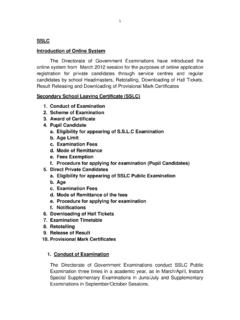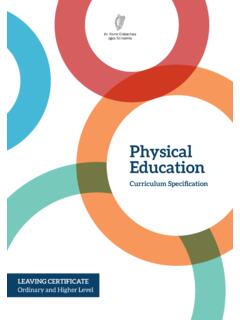Transcription of New Leaving Certificate Grading Scale and Revised Common ...
1 New Leaving Certificate Grading Scale and Revised Common Points ScaleSeptember 2015 The Universities and the Institutes of Technology have been working in partnership with the Department of Education and Skills to bring about progressive and incremental enhancements of the transition from second to third level. The central focus of this work has been to agree reforms of Leaving Certificate assessment and Grading and the admissions processes to higher education, in order to mitigate some of the undesirable effects of the so-called points system .New Leaving Certificate Grading Scale and Revised Common Points ScaleAs part of this process, it has been agreed to change how the Leaving Certificate examinations are graded, using fewer broader grade bands.
2 The current 14-point Grading Scale (A1, A2, B1, B2, B3, etc. where the grade bands typically cover 5%) will be replaced by an 8-point Scale (based on a grade band 10% wide). This requires a new Common Points Scale . The revisions to the Common Points Scale and associated adjustments are being made jointly by the universities and the Institutes of Technology. These Revised arrangements have been the subject of extensive discussions with the Higher Education Institutions (HEIs) and their governance structures during the period of development. The Revised arrangements will be applied by all universities, institutes of technology and their linked providers from Leaving Certificate Grading Scale in 2017 The Department of Education and Skills will introduce a new Leaving Certificate Grading Scale in 2017.
3 The new Scale has 8 grades, the highest grade is a Grade 1, the lowest grade a Grade 8. The highest seven grades 1-7 divide the marks range 100% to 30% into seven equal grade bands 10% wide, with a grade 8 being awarded for percentage marks of less than 30%. The grades at higher level and ordinary level are distinguished by prefixing the grade with H or O respectively, giving H1-H8 at higher level, and O1-O8 at ordinary new 8-point Grading Scale will replace the current 14-point Scale at both Higher and Ordinary levels. Currently, the majority of students receiving a given grade are within 3 percentage marks of a higher grade, and 5 extra points, creating pressure towards rote learning and using the marking scheme to gain those few additional marks.
4 NEW GRADES % MARKSH1 / O190-100H2 / O280<90H3 / O370<80H4 / O460<70H5 / O550<60H6 / O640<50H7 / O730<40H8 / O80<30 Table 1: New LC Grading Scale , to be introduced in 2017 The new broader grade bands will ease the pressure on students to achieve marginal gains in examinations and encourage more substantial engagement with each subject. The new Grading system will also allow for greater flexibility, variety and innovation in Leaving Certificate assessments. The broader objective is to allow for an enhanced learner experience in senior cycle, with a greater focus on the achievement of broader learning new 8-point Scale moves the Irish Leaving Certificate closer to school Leaving examinations in other countries, such as Scotland, England, Wales and Northern Ireland, Finland, and to the International Baccalaureate.
5 The Irish universities, Institutes of Technology and all other colleges which accept applications through the CAO, will introduce a Revised Common Points Scale in 2017, as follows:HigherOrdinaryGRADEPOINTSGRADEPO INTSH1100H288H377H466H556O156H646O246H73 7O337H80O428O520O612O70O80 The main features of this Revised Common Points Scale can be summarised as follows:n A Revised points Scale is required as a result of the new 2017 LC grade The Revised points Scale maintains the current alignment between the points awarded for achievement at Higher Level and the points awarded for achievement at Ordinary Level. The validity of this alignment has been confirmed by research conducted by the Education Research Centre. This ensures that due recognition is given to a broad range of second-level learning achievements and will encourage and promote wide participation in higher education.
6 N The Revised points Scale will minimise the use of random selection in the admissions process, by minimising the number of candidates presenting with identical points scores. This is achieved by using a non-linear points Scale , which distributes candidates across the full range of possible points scores (0 600). The new Scale has been optimised based on extensive mathematical analysis and modelling of the distributions of points scores that would result from different non-linear Common Points Scale in 2017 Table 2: Revised Common Points Scale , to be introduced in 2017n The Revised points Scale will award points for the new H7 grade. This is designed to encourage the take-up of higher level curricula in senior cycle, and to reduce the risk of taking higher level examinations.
7 At present, many students (up to 20% in some subjects) withdraw from higher level close to the LC examination. Furthermore, the research conducted by the Education Research Centre confirms that the level of achievement represented by a H7 is equivalent to the level of achievement represented by an O3, and the State Examinations Commission will reinforce this alignment through its standard-setting and Grading processes. Given that points will be awarded for an O3, it is appropriate to award the same number of points for a H7 The Revised points Scale is also designed to reward high levels of performance in some subjects above more even performance across a broader number of subjects. The Revised Scale distinguishes between applicants who would otherwise, under the existing points Scale , achieve equal aggregate points scores.
8 For example, under the current points Scale , an applicant with 6 higher level C1 grades is awarded 420 points. An applicant with 3 higher level C3 grades and 3 higher level B2 grades is also awarded 420 points. Under the new points Scale , in 2017 an applicant with 6 H4 grades will be awarded 396 points, while an applicant with 3 H3 grades and 3 H5 grades will be awarded 399 bonus points will continue be awarded in 2017 for higher level mathematics, at grades H6 and above, in a manner similar to the present the non-linear design and other features of the new points Scale , a simple comparison of an applicant s points score under the new Scale with the pre-2017 points Scale will not be possible. Students will, on average, receive slightly less points than under the current system.
9 However, all students applying through the CAO from 2017 will be awarded the new points, no matter when they sat the Leaving Certificate . This means that all students applying through the CAO will be on a level a result of the new Leaving Certificate grades, in 2017 the universities and Institutes of Technology will also introduce Revised basic matriculation requirements, as follows:n Where the requirements are currently 5 ordinary level D3 grades, in 2017 these will become 5 O6/H7 Where the requirements are currently 2 higher level C3 grades and 4 ordinary level D3 grades, in 2017 these will become 2 H5 and 4 O6/H7 grades. n Where the requirements are currently 3 higher level C3 grades and 3 ordinary level D3 grades, in 2017 these will become 3 H5 and 3 O6/H7 grades.
10 Bonus points for MathematicsRevised Basic Matriculation requirements in 2017 Subject requirements which form part of basic matriculation remain unchanged. Any Revised subject requirements specific to individual courses for 2017 will be approved and published by each HEI over the coming 2017 the points awarded for QQI-FET (formerly FETAC) awards will also be Revised . This is required to maintain the existing equivalence with the current points Scale , and reflects the overall marginal reductions in student points scores under the new points the maximum possible total score of 360 (120 credits x 3 for a distinction) is multiplied by 10 and divided by 9 to give a maximum overall points score of 400. From 2017, this maximum possible total score of 360 will be multiplied by 13 and divided by 12, to give a Revised maximum overall points score of 390 for applicants from further education and for Leaving Certificate Vocational Programme (LCVP) Link Modules are aligned with the current Leaving Certificate Grading scheme and equivalent points.

![FORM 16 [rule 14] FOR STUDENTS EDUCATION De-Notified …](/cache/preview/d/4/3/0/c/8/c/e/thumb-d430c8ce06fef35e8338a4b2d936adb9.jpg)







